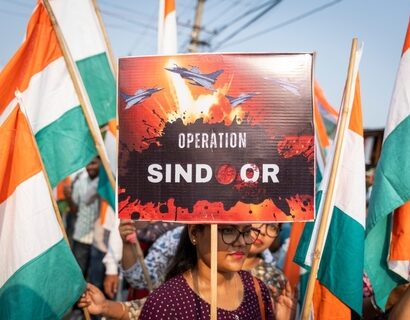Abstract: The particular security challenges nations might face, whether it be during times of peace or conflict, are uncertain. Besides all uncertainty, nations inevitably require adequate apparatus to tackle contemporary challenges. Overcoming the most complex security challenges produced by hybrid warfare for the military requires effective adaptive management approaches, adaptive leadership and innovative problem-solving.
Bottom-line-up-front: Developing more sustainable and efficient management skills and styles is imperative to mitigate a hybrid conflict’s uncertain environment and assist in handling problematic tasks which require adaptable organizations. Such organizations are capable of forming adaptive leaders.
Problem statement: How can the security challenges in a volatile environment be overcome from an organizational perspective?
So what?: An innovative approach to a problem with out-of-the-box perspectives could take inflexible organizations out of their existing restricting frameworks. Consequentially, this could lead to resolving issues and the development of skills for success within the operating environment.

Source: shutterstock.com/LightField Studios
Complexity as Structural Challenge
In times of peace and in conflict, military personnel operate in a complex operational environment and should, therefore, always be ready to act and respond to various challenges involving security dilemmas. In his article, “Hybrid Warfare and Challenges,” Lieutenant Colonel Frank Hoffman states that hybrid warfare creates an operational environment wherein states are not prepared to fight. Armed forces must be flexible and adapt to unpredictable challenges as well.[1] In general, armed forces must pay attention to diverse challenges and different potential adversary strategies due to the risks of conflict diversities. In his work “Adaptive Leadership in the Military Decision Making Process,” Lieutenant Colonel William Cojocar asserts that hybrid threats are innovative, adaptive, globally connected, interactive and implanted in local populations. The operational goal of a hybrid threat lies in its temporary adaption to the operational environment. It achieves this aim through means of patience, adapting tactics, techniques, procedures, and strategic objectives to live and fight for another day. It is uncertain what specific security challenges nations might suddenly face, whether it be during periods of peace or conflict.[2] Besides all uncertainty, it is inevitable that nations are equipped with adequate apparatus to handle the challenges mentioned above. Overcoming the most complex security challenges for the military as a result of hybrid warfare requires practical tools such as adaptive management approach, adaptive leadership, and innovative problem-solving.
The operational goal of a hybrid threat lies in its temporary adaption to the operational environment. It achieves this aim through means of patience, adapting tactics, techniques, procedures, and strategic objectives to live and fight for another day.
Adaptive Management and Leadership
An adaptive management approach explores uncertain situations and plans for surprising results through the constant collection of information. Adaptation is an action undertaken to improve execution established on the outcomes of observation. There are specific examples of adaption to challenging operational environment from the military operational viewpoint in modern warfare environments. Correspondingly, Major John Davis outlines in his article on “Defeating Future Hybrid Threats” that Hezbollah’s tactics promptly transitioned the environment of the conflict from conventional warfare to hybrid warfare by effectively opposing the Israeli Defense Forces’ (IDF) technological superiority through using all available resources to adapt. Consequently, Hezbollah’s efforts brought Israel to the bargaining table and ultimately to a cease-fire agreement.[3] Illustratively, Hezbollah applied an adaptive approach in its management structure. They have demonstrated a well-developed relationship between management structure and subordinates. Military leaders are educated and trained to respond to challenging situations in an operational environment.
Even though modern technologies and equipment unite to meet hybrid warfare’s contests, leaders ought to enable the military organization to be flexible and capable of multitasking in a volatile environment with uncertain consequences.
An equally important factor for overcoming challenges is encouraging adaptive leadership, also connected with adaptive management. The encouragement of adaptive leadership enables leaders to understand how human performance can affect operational effort in a fast-changing security environment.[4] In their work “The Influence of Complex Adaptive Leadership on the Efficiency of Business Management” Apenko Svetlana and Chernobaeva Gulnara claim that leaders who have exceptional adaptive leadership skills are more likely to be successful in fast-changing systems.[5] As an example, the operational environment during the Iraq war was characterized by an unpredictable and chaotic setting that inevitably transformed leaders into quick, responsive and mentally tough managers – or into organizational problems. Since the time spent in garrison and on training differs massively from battlefield realities, the US Army had to go through a transformational process which was not easy due to the entity’s size and tall hierarchical structure. Nonetheless, critical and demanding challenges require organizational adaptation along with adaptive leaders. Supporting the rise of adaptive leadership within all areas of the organizational structure is a starting point for an innovative environment. This cannot be achieved without an organizational structure that imposes an adaptive management approach to build future leaders.
Supporting the rise of adaptive leadership within all areas of the organizational structure is a starting point for an innovative environment.
In a military conflict, innovative problem solving relates to the ability to think critically, evaluate problems and find appropriate solutions for obstacles in uncertain security environments. Such obstacles make it challenging to achieve an objective, a desired goal or end state for a military operation. Challenges that occur from a hybrid warfare environment include open-end problems that cannot be overcome with pre-established and standardized procedures. Charles Allen stated that operating effectively in a military environment requires leaders with sophisticated cognitive skills appropriate for the multiple demands of complex security environments. Not to mention, leaders must also be quick learners, adaptable when necessary, anticipative of the future, and mentally agile. Creative tactical decisions can be arrived at through communicating a mission’s purpose via the appropriate and accepted domestic channels, planning requirements before they surge and solving problems at hand. The actions triggered by these creative but requirement-focused decisions might maintain the mission’s execution according to the commander’s intent to win the hearts and minds of the local population. An innovative approach to a problem with out-of-the-box perspectives could take inflexible organizations out of pre-existing restrictive frameworks. This could lead to the resolvement of issues and the development of skills for success in the operating environment.
An innovative approach to a problem with out-of-the-box perspectives could take inflexible organizations out of pre-existing restrictive frameworks.
Adaptable Leaders in Learning Organizations
Adaptable organizations that produce adaptive leaders are impartial to developing more sustainable and efficient management skills and styles that can mitigate a hybrid conflict’s uncertain environment and handle problematic tasks. Adaptive leaders in adaptable, learning organizations are effective instruments against unforeseen security problems. Contrastingly, powerful and rigid organizations are like robust defense fortifications: they fall against the most minor, but deceptive and flexible enemy.
Anes Zukić, is an officer in the Armed Forces of Bosnia-Herzegovina. He graduated from the US Army Command and General Staff College and received a Master of Military Arts and Sciences degree. The views contained in this article are the author’s alone and do not represent the views of the Armed Forces of Bosnia-Herzegovina, the Ministry of Defense of Bosnia-Herzegovina, or the Bosnia-Herzegovina Government.
[1] Frank G.Hoffman, Hybrid Warfare and Challenges, JFQ: Joint Force Quarterly (2009), (52), 34–39.
[2] William J. Cojocar, Adaptive Leadership in the Military Decision Making Process, Military Review (2011), 91(6), 29–34.
[3] John R. Davis Jr, Defeating Future Hybrid Threats, Military Review (2013), 93(5), 21–29.
[4] Ayodele Otaiku, A Framework for Hybrid Warfare:Threats,Challenges and Solutions (2018).
[5] Apenko Svetlana and Chernobaeva Gulnara, The Influence of Complex Adaptive Leadership on the Efficiency of Business Management. Proceedings of the European Conference on Management, Leadership & Governance (2016), 17–24.





